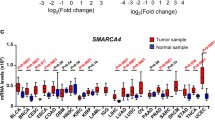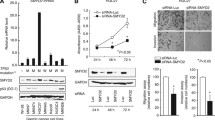Abstract
Background
Aberrant expression of SWI/SNF complex subunits is closely associated with tumorigenesis. The clinicopathological and prognostic significance of altered SMARCA2 and SMARCA4 subunits has not been well evaluated in gastric adenocarcinoma.
Methods
We collected 1271 postoperative cases of gastric adenocarcinoma and then constructed tissue microarrays (TMA), from which we obtained the immunohistochemistry expression of SMARCA2 and SMARCA4. Next, we screened the variables related to the loss of SMARCA2 and SMARCA4 by univariate correlation analysis and multivariate logistic regression analysis. Then, we identified the variables related to prognosis by univariate and multivariate Cox regression analysis. Finally, we constructed a nomogram prognostic model and evaluated it.
Results
The loss of SMARCA2 and SMARCA4 occurred in 236 (18.57%) and 86 (6.77%) cases, respectively, including 26 cases of co-loss. After multivariate logistic regression, variables independently associated with SMARCA2 loss were T stage, differentiation status, WHO histological classification, and EBER. Variables independently associated with SMARCA4 loss were differentiation status, WHO histological classification, PD-L1, and MMR. Survival analysis revealed that the SMARCA2 and SMARCA4 lost groups showed worse survival than the corresponding present groups (P = 0.032 and P = 0.0048, respectively). Univariate and multivariate Cox analyses identified independent prognostic factors, including age, T stage, N stage, M stage, SMARCA2, and chemotherapy.
Conclusion
The loss of SMARCA2 and SMARCA4 correlated with poor differentiation, leading to a worse prognosis. SMARCA2, as an independent prognostic factor, combined with other clinicopathological variables, established a novel nomogram prognostic model, which outperformed the AJCC TNM model.







Similar content being viewed by others
Data availability
The datasets for this study are available from the corresponding author.
References
Sung H, Ferlay J, Siegel RL et al (2021) Global cancer statistics 2020: GLOBOCAN estimates of incidence and mortality worldwide for 36 cancers in 185 countries. CA Cancer J Clin 71(3):209–249
Zhang XY, Zhang PY (2017) Gastric cancer: somatic genetics as a guide to therapy. J Med Genet 54(5):305–312
Gao JP, Xu W, Liu WT et al (2018) Tumor heterogeneity of gastric cancer: from the perspective of tumor-initiating cell. World J Gastroenterol 24(24):2567–2581
Narlikar GJ, Sundaramoorthy R, Owen-Hughes T (2013) Mechanisms and functions of ATP-dependent chromatin-remodeling enzymes. Cell 154(3):490–503
Clapier CR, Iwasa J, Cairns BR et al (2017) Mechanisms of action and regulation of ATP-dependent chromatin-remodelling complexes. Nat Rev Mol Cell Biol 18(7):407–422
Alfert A, Moreno N, Kerl K (2019) The BAF complex in development and disease. Epigenetics Chromatin 12(1):19
Mittal P, Roberts CWM (2020) The SWI/SNF complex in cancer - biology, biomarkers and therapy. Nat Rev Clin Oncol 17(7):435–448
Centore RC, Sandoval GJ, Soares LMM et al (2020) Mammalian SWI/SNF chromatin remodeling complexes: emerging mechanisms and therapeutic strategies. Trends Genet 36(12):936–950
Huang SC, Ng KF, Chang IY et al (2021) The clinicopathological significance of SWI/SNF alterations in gastric cancer is associated with the molecular subtypes. PLoS ONE 16(1):e0245356
Gluckstein MI, Dintner S, Arndt TT et al (2021) Comprehensive immunohistochemical study of the SWI/SNF complex expression status in gastric cancer reveals an adverse prognosis of SWI/SNF deficiency in genomically stable gastric carcinomas. Cancers (Basel) 13 (15)
Chiba H, Muramatsu M, Nomoto A et al (1994) Two human homologues of Saccharomyces cerevisiae SWI2/SNF2 and Drosophila brahma are transcriptional coactivators cooperating with the estrogen receptor and the retinoic acid receptor. Nucleic Acids Res 22(10):1815–1820
Reisman DN, Sciarrotta J, Bouldin TW et al (2005) The expression of the SWI/SNF ATPase subunits BRG1 and BRM in normal human tissues. Appl Immunohistochem Mol Morphol 13(1):66–74
Wang X, Sansam CG, Thom CS et al (2009) Oncogenesis caused by loss of the SNF5 tumor suppressor is dependent on activity of BRG1, the ATPase of the SWI/SNF chromatin remodeling complex. Cancer Res 69(20):8094–8101
Mardinian K, Adashek JJ, Botta GP et al (2021) SMARCA4: implications of an altered chromatin-remodeling gene for cancer development and therapy. Mol Cancer Ther 20(12):2341–2351
Xia QY, Zhan XM, Fan XS et al (2017) BRM/SMARCA2-negative clear cell renal cell carcinoma is associated with a high percentage of BRM somatic mutations, deletions and promoter methylation. Histopathology 70(5):711–721
Jancewicz I, Siedlecki JA, Sarnowski TJ et al (2019) BRM: the core ATPase subunit of SWI/SNF chromatin-remodelling complex-a tumour suppressor or tumour-promoting factor? Epigenetics Chromatin 12(1):68
Ouyang X, Ye XL, Wei HB (2017) BRM promoter insertion polymorphisms increase the risk of cancer: a meta-analysis. Gene 626:420–425
Bourachot B, Yaniv M, Muchardt C (2003) Growth inhibition by the mammalian SWI-SNF subunit Brm is regulated by acetylation. EMBO J 22(24):6505–6515
La Rochelle J, Klatte T, Dastane A et al (2010) Chromosome 9p deletions identify an aggressive phenotype of clear cell renal cell carcinoma. Cancer 116(20):4696–4702
Puliga E, Corso S, Pietrantonio F et al (2021) Microsatellite instability in gastric cancer: between lights and shadows. Cancer Treat Rev 95:102175
Jelinic P, Ricca J, Van Oudenhove E et al (2018) Immune-active microenvironment in small cell carcinoma of the ovary, hypercalcemic type: rationale for immune checkpoint blockade. J Natl Cancer Inst 110(7):787–790
Naito T, Umemura S, Nakamura H et al (2019) Successful treatment with nivolumab for SMARCA4-deficient non-small cell lung carcinoma with a high tumor mutation burden: a case report. Thorac Cancer 10(5):1285–1288
Peng L, Li J, Wu J et al (2021) A pan-cancer analysis of SMARCA4 alterations in human cancers. Front Immunol 12:762598
Guerrero-Martinez JA, Reyes JC (2018) High expression of SMARCA4 or SMARCA2 is frequently associated with an opposite prognosis in cancer. Sci Rep 8(1):2043
Zhang Z, Wang F, Du C et al (2017) BRM/SMARCA2 promotes the proliferation and chemoresistance of pancreatic cancer cells by targeting JAK2/STAT3 signaling. Cancer Lett 402:213–224
Xu X, Zheng Z, Jia L et al (2018) Overexpression of SMARCA2 or CAMK2D is associated with cisplatin resistance in human epithelial ovarian cancer. Oncol Lett 16(3):3796–3804
Wu Q, Lian JB, Stein JL et al (2017) The BRG1 ATPase of human SWI/SNF chromatin remodeling enzymes as a driver of cancer. Epigenomics 9(6):919–931
Chang B, Sheng W, Wang L et al (2021) SWI/SNF complex-deficient undifferentiated carcinoma of the gastrointestinal tract: clinicopathologic study of 30 cases with an emphasis on variable morphology, immune features, and the prognostic significance of different SMARCA4 and SMARCA2 subunit deficiencies. Am J Surg Pathol
Agaimy A, Daum O, Markl B et al (2016) SWI/SNF Complex-deficient undifferentiated/rhabdoid carcinomas of the gastrointestinal tract: a series of 13 cases highlighting mutually exclusive loss of SMARCA4 and SMARCA2 and frequent co-inactivation of SMARCB1 and SMARCA2. Am J Surg Pathol 40(4):544–553
Karnezis AN, Wang Y, Ramos P et al (2016) Dual loss of the SWI/SNF complex ATPases SMARCA4/BRG1 and SMARCA2/BRM is highly sensitive and specific for small cell carcinoma of the ovary, hypercalcaemic type. J Pathol 238(3):389–400
Herpel E, Rieker RJ, Dienemann H et al (2017) SMARCA4 and SMARCA2 deficiency in non-small cell lung cancer: immunohistochemical survey of 316 consecutive specimens. Ann Diagn Pathol 26:47–51
Ramalingam P, Croce S, McCluggage WG (2017) Loss of expression of SMARCA4 (BRG1), SMARCA2 (BRM) and SMARCB1 (INI1) in undifferentiated carcinoma of the endometrium is not uncommon and is not always associated with rhabdoid morphology. Histopathology 70(3):359–366
Chetty R, Serra S (2020) SMARCA family of genes. J Clin Pathol 73(5):257–260
Sun S, Li Q, Zhang Z et al (2022) SMARCA2 deficiency in NSCLC: a clinicopathologic and immunohistochemical analysis of a large series from a single institution. Environ Health Prev Med 27:3
Kahali B, Gramling SJ, Marquez SB et al (2014) Identifying targets for the restoration and reactivation of BRM. Oncogene 33(5):653–664
Chan-Penebre E, Armstrong K, Drew A et al (2017) Selective killing of SMARCA2- and SMARCA4-deficient small cell carcinoma of the ovary hypercalcemic type cells by inhibition of EZH2: in vitro and in vivo preclinical models. Mol Cancer Ther 16 (5):850–860
O’Neil NJ, Bailey ML, Hieter P (2017) Synthetic lethality and cancer. Nat Rev Genet 18(10):613–623
Shiraishi N, Sato K, Yasuda K et al (2007) Multivariate prognostic study on large gastric cancer. J Surg Oncol 96(1):14–18
Zhou ZR, Wang WW, Li Y et al (2019) In-depth mining of clinical data: the construction of clinical prediction model with R. Ann Transl Med 7(23):796
Acknowledgements
Not applicable.
Funding
None.
Author information
Authors and Affiliations
Contributions
Study design: ZZ, SZ. Patient tissue collection: ZZ, SS, ZL, SX. Pathology review: SZ, ZZ, QJL. Supply of reagents: QL, YZ. Data analysis: ZZ, SS. Manuscript: ZZ. Manuscript review: SZ, ZGC.
Corresponding author
Ethics declarations
Conflict of interest
The authors declare that they have no competing interests.
Ethical approval
This study was approved by the Ethics Review Board of the Weihai Municipal Hospital (permission code: 2,021,053).
Informed consent
Informed consent was obtained from patients before enrollment in this study.
Consent for publication
Not applicable.
Additional information
Publisher's Note
Springer Nature remains neutral with regard to jurisdictional claims in published maps and institutional affiliations.
Supplementary Information
Below is the link to the electronic supplementary material.
About this article
Cite this article
Zhang, Z., Li, Q., Sun, S. et al. Expression of SMARCA2 and SMARCA4 in gastric adenocarcinoma and construction of a nomogram prognostic model. Int J Clin Oncol 28, 1487–1500 (2023). https://doi.org/10.1007/s10147-023-02403-0
Received:
Accepted:
Published:
Issue Date:
DOI: https://doi.org/10.1007/s10147-023-02403-0




